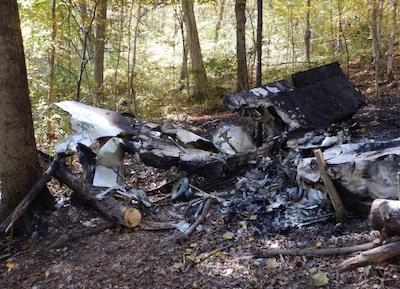Tue, Apr 24, 2018
Found Alcohol And Marijuana In His System When Accident Occurred
The NTSB has released its probable cause report from an accident in which the pilot of a Van's RV-4 struck a zipline cable in Oregonia, OH on October 16, 2016.

The pilot and a passenger were fatally injured when the airplane, an amateur-built RV-4 impacted the cable and terrain while maneuvering at low altitude in Oregonia, OH. The airplane was destroyed by impact forces and a postimpact fire. Several witnesses in various locations reported seeing the airplane flying at low altitude before the accident. Witnesses near the accident site reported that the airplane was traveling south along the river. One witness estimated that the airplane was about 30 ft above the river, and another estimated that it was about 50 ft above the tree tops. Both witnesses reported the engine sounded "strong" and at "full power." One witness momentarily lost sight of the airplane; when it came back into view, the airplane descended into the trees.
According to the probable cause report, the cable ran between wooden platforms on the east and west sides of a river about 170 ft above ground level. The location of the platforms in wooded areas and the fact that the cable was unmarked likely made the zipline difficult to see. Witness statements and the accident scenario indicate the pilot operated the airplane at extremely low altitudes throughout the flight.
Toxicological testing of the pilot was positive for ethanol and tetrahydrocannabinol (THC, the primary psychoactive substance in marijuana). The blood level of ethanol was below the regulatory limit; however, pilots may be impaired below this threshold. The finding of THC indicated that the pilot had used marijuana sometime before the accident; however, since there is no accepted relationship between blood levels and degree of impairment, whether the impairing effects of THC contributed to the accident could not be determined.
The probable cause was listed as being "The pilot's decision to fly at a low altitude, which resulted in the collision with a zipline."
(Image from NTSB accident docket)
More News
Pilot Also Reported That Due To A Fuel Leak, The Auxiliary Fuel Tanks Were Not Used On June 4, 2025, at 13:41 eastern daylight time, a Piper PA-23, N2109P, was substantially damage>[...]
Have A Story That NEEDS To Be Featured On Aero-News? Here’s How To Submit A Story To Our Team Some of the greatest new stories ANN has ever covered have been submitted by our>[...]
From 2023 (YouTube Edition): Reflections on War’s Collective Lessons and Cyclical Nature The exigencies of war ought be colorblind. Inane social-constructs the likes of racis>[...]
Aero Linx: Colorado Pilots Association (CPA) Colorado Pilots Association was incorporated as a Colorado Nonprofit Corporation in 1972. It is a statewide organization with over 700 >[...]
High Speed Taxiway A long radius taxiway designed and provided with lighting or marking to define the path of aircraft, traveling at high speed (up to 60 knots), from the runway ce>[...]
 NTSB Prelim: Piper PA-23
NTSB Prelim: Piper PA-23 ANN FAQ: Submit a News Story!
ANN FAQ: Submit a News Story! Classic Aero-TV: One Mans Vietnam
Classic Aero-TV: One Mans Vietnam ANN's Daily Aero-Linx (07.03.25)
ANN's Daily Aero-Linx (07.03.25) ANN's Daily Aero-Term (07.03.25): High Speed Taxiway
ANN's Daily Aero-Term (07.03.25): High Speed Taxiway



